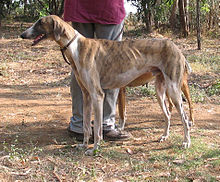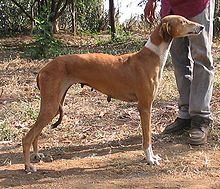- Mudhol Hound
-
Mudhol Hound 
A Mudhol Hound (Caravan Hound). Other names Mudhol Dog
Caravan Hound
Karwani
Lahori Pashmi
Pashmi
Pisuri HoundCountry of origin India (Deccan Plateau) Traits Classification and standards Not recognized by any major kennel club Dog (Canis lupus familiaris) The Mudhol Hound is an Indian breed of dog of the sight hound type. The breed is also known as Caravan Hound and the feathered variety is commonly referred to as a Pashmi. In the villages he is known as the Karwani. It is a common companion amongst village folk in India's Deccan Plateau, who use the dog for hunting and guarding.
The Kennel Club of India (KCI) and Indian National Kennel Club (INKC) recognize the breed under different breed names. The KCI registers it as a Caravan Hound while the INKC goes with the name Mudhol Hound.
Contents
Description
Appearance
The Mudhol/Caravan of today has well-defined characteristics. The head is long and narrow, broad between the ears with a tapering muzzle. The jaws are long and powerful, with a scissors bite. The nose is large, and may be black, liver, or flesh coloured. The ears are medium sized, very slightly rounded at the tips, and hang close to the skull. The eyes are large and oval in shape, and may be dark or light in colour. The expression is a piercing gaze. The neck is long, clean, and muscular, and fits well into the shoulders. The forelegs are long, straight and well-boned. The males are 68–72 cm in height at the withers and the females are 64–68 cm tall. The back is long, broad and well-muscled. The loins are wide and deep. The chest is strong and deep with well sprung ribs. The abdomen is tucked in. The hind quarters appear wide and well-muscled. The tail is strong at the base, not too long, set low and carried in a natural curve. The gait is high-footed, flexing all four legs, but should not be hackneyed. There are two coat varieties—one with an entirely smooth coat and the other with silky featherings on the ears, legs, and tail. All colours and combinations of colours are acceptable.
Temperament
The breed is above all a working hound, capable of providing an excellent performance in the field on a consistent basis, under gruelling conditions that would decimate most other dogs. It is therefore elegant, graceful and courageous. Its physical strength couples with great speed and plenty of stamina to allow it to catch and kill several types of game, from hare to blackbuck, over rough country. It is not an ideal dog for the apartment dweller, as it needs a great deal of space to exercise, although if arrangements are made to exercise the dog regularly in a sufficiently large, safely fenced area, it may do well in a flat or any other dwelling.
The breed, if treated with kindness and respect, can be exceptionally loyal. They are not very friendly, and do not like to be touched by strangers. However, a Caravan should never be aggressive, as this sort of temperament is not ideal for a hunting dog, which must tolerate other dogs and human beings, especially when they are not intruding on his territory. It makes a reasonable watch dog, and can protect that which he holds dear, should the need arise. He should always be treated in a kind, consistent, fair, and respectful manner, otherwise he may develop a nervous or vicious nature -- either of which are difficult to live with.
History
The Mudhol/Caravan is an ancient breed, native to the Deccan Plateau of western India. This region covers parts of the states of Karnataka, Maharashtra, and, to a lesser degree, Andhra Pradesh. The name, Karwani, endures to this day in the villages, but it was anglicized to Caravan Hound when the Kennel Club of India recognized the breed.
Many hound dog varieties like the Saluki and the Afghan Hound were brought by the Pathans, Arabs, Persians and Afghans when they came to India through the Khyber Pass. The Karwani is probably descended from these dogs. They followed their nomad masters in caravans from place to place, hence the name - Caravan Hound. It is said that the Afghans were given lands to act as a buffer between Aurangazeb's Deccan kingdom and the Maratha Empire, therefore the dogs are also found in the same area. They were bred for their functional qualities like the ability to withstand the harsh weather, hunting skills, speed and endurance, among others, rather than for aesthetic qualities.
In Karnataka, the breed is also known as the Mudhol Hound, after a small town in Bagalkot District. A former ruler of Mudhol, Sri Srimanth Raja Malojirao Gorphade (Maloji Rao Ghorpade), is said to have presented a pair of hound puppies to King George V of England. Upon inspecting these curiosities, the monarch found them true to sighthound conformation and dubbed them “the Hounds of Mudhol”.
It is found not only in Mudhol, but is widely kept throughout the Deccan; however, the Indian National Kennel Club uses the Mudhol Hound name.
External links
- Mudhol Hound with pictures, including Pashmi variety
- Mudhol Hound
- Mudhol Hound has its day - news article in The Hindu
- Caravan Hound Preservation Society International
- Detailed article about the Mudhol/Caravan Hound
Categories:- Hounds
- Sighthounds
- Dog breeds originating in India
Wikimedia Foundation. 2010.

